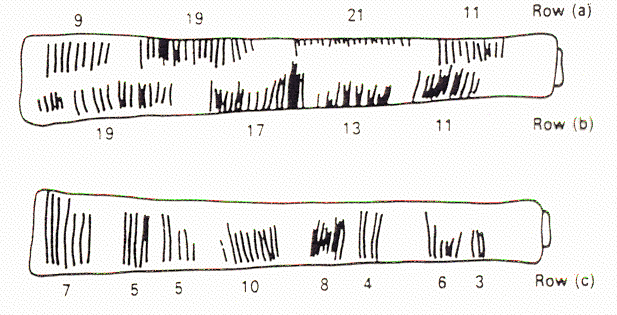
| More on the Ishango Bone. It is said that the markings signify that there was deeper understanding of numbers. It is said that they were fascinated by prime numbers too: row (b) contains all the 4 primes between 10 and 20. Row (a) is said to be craved based on the knowledge that 10-1, 20-1, 20+1, 10+1 represent some sort of pattern: these are the numbers that differ from 10 and 20 by 1. Row (c) seems to show knowledge of doubling (2�3=6, 2�4=8, 2�5=10), halving (6/3=8/4=10/5=2) and difference of 2 (7-5). Definitely this interpretation is highly controversial, as all these seem too advance for the Paleolithic. |  |
Geometry came in next about 25,000BC with simple geometric shapes. The Paleolithic humans probably are capable of drawing simple geometric shape with a stone or a stick to represent the moon, the sun or anything they see in their everyday life way before the 25,000BC. However, this is not considered Geometry but simply as painting. It can only be treated as Mathematics if there is abstraction or calculation involved. Mathematics could not advance if human remain hunter-gatherers. Around 10,000BC agriculture was invented and with that came the need to keep accounts and maintain farm areas.
The Egyptians devised their own calendar at 4000BC. At 3400BC, Egyptian Hieroglyphic numerals took shape.
| 1 | 10 | 100 | 1,000 | 10,000 | 100,000 | 1,000,000 |
They built the Great Pyramid of Giza at 2650BC. However, Hieroglyphic requires many symbols for calculation, so Hieratic was developed. Hieratic has symbols for 1-10, 20, 30, ...,100, 200, ..., 1000, 2000, ..., 9000. The Egyptians made the first mathematical manuscripts in 1900BC: the Moscow Papyrus which contained 25 problems on Geometry. In 1700BC, Ahmes produced the Rhind Papyrus which contained even more problems, altogether 87 on Arithmetic, Algebra and Geometry. Ahmes was a scribe and he mentioned that he copied the Rhind Papyrus from a document 200 years old.
The Chinese calendar began around 2953BC and is based on the lunar cycles. It's still in use today. At 2000BC, Yu the emperor is said to have encountered magic squares. The first evidence of Chinese numerals is at 1400BC, where records are found on bones and tortoise shells. It is a decimal place-valued system (with a space to represent zero). The Chinese used counting boards at 1000BC and counting rods at 540BC. Pythagoras Theorem is known to the Chinese before Pythagoras. Most of the history of Chinese Mathematics was destroyed during 213BC when the emperor of unified China of Qin Dynasty ordered all books and scholars to be burnt. The earliest existing manuscript is the Chou-pei Suan-ching (Zhou Bi Suan Jing), which dealt with problems in Arithmetic, Algebra and Geometry (300BC). The most noted is the ancient manuscripts known as Chiu-chang Suan-shu (Jiu Zhang Suan Shu) which has 9 chapters with 246 problems on Algebra, Number Theory and Geometry (200BC).
In the literature, ancient Indian mathematics refer to the mathematics of the Indian subcontinent. The Indus or Harappan civilization existed at 3000BC in the Indus Valley of Pakistan. They have a system of weight and measure based on a decimal system. Many of the weights were of the shapes of cone, cuboid, cylinder, etc. They also have artistic drawings of concentric circles and triangles. Although the Vedic religion is believed to exist before 4000BC, significant link to mathematics (and astronomy) only came in around 2000BC. The Sulbasutra is a series of works dated from 800-200BC of the Vedic period. The sutra shows that the Indians work with irrational numbers, Pythagoras Theorem, certain quadratic equations. In the sutra can be found different values of π ranging from approx. 3 to 3.2. They did better in getting the value of √2, which is correct to 5 decimal places. Their results were of course all in fractions rather than decimals. The Arabic number system (1, 2, 3, ...) that we are now so familiar has its roots in Indian Brahmi numerals.
The Greek era of Mathematics started with Thales when he brought Egyptian Mathematics into Greece at 575BC and it lasted till 400AD. The Greeks made such great contributions to Mathematics that it shaped the future of Mathematics. As the years went pass, other civilizations made their contributions, these included the Mayans and Arabs.
Return to Maths Homepage